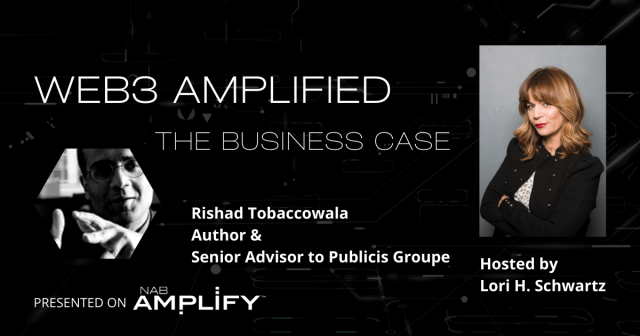Watch This: Web3’s Knowns and Unknown Unknowns
TL;DR
- The metaverse is essentially a digital twin of the physical world.
- Interoperability and, therefore, efficiency will be a major benefit of Web3.
- Web3 is more than just a B2C concept; it will transform business.
Listen to the Interview
Lori H. Schwartz continues our Web3 Amplified series, this time in conversation with Barbara Marshall. They dive into the technology that creatives will need in order to make the metaverse possible, explore business models, and consider how far we are from the reality of a true Web3.
Marshall is Global M&E Industry lead for Z by HP. She also currently serves on NAB’s Web3 Advisory Council. Previously, she’s had roles at the BBC, Autodesk, Epic Games and now HP Inc.
At HP, Marshall’s work focuses on the workstations used by visual effects, animation, broadcasters, video post-production companies and other M&E roles that require a lot of compute power today.
What We Don’t Know *Yet* About the Metaverse
First, Marshall notes that computers are necessary to create “the digital world in whatever form it takes.” When you’re talking about a graphics intensive digital environment, what many are now referring to as the metaverse, a category of computer known as workstations are required. HP “obviously has a part to play in creating the computers that enable the creatives to create the metaverse.”
Those are the known, basic elements of this Web3 conversation, according to Marshall.
Whether or not the metaverse will be “one huge digital replica of the world” or there might be multiple metaverses, each different in form and function (per Marshall, the latter seems to be the general consensus).
For her money, Marshall explains it like this: “The metaverse is the digital twin of anything that exists physically. It’s the possibility of interconnecting all of these digital twins, all of these digital environments. … What possibilities does that open up?”
The metaverse is the digital twin of anything that exists physically. It’s the possibility of interconnecting all of these digital twins, all of these digital environments.
Barbara Marshall
As of late 2022, some movies have begun “exploring the concept of these digital worlds that people can immerse themselves in,” Marshall says, citing “Avatar” and “Don’t Worry, Darling” as recent examples.
But M&E isn’t alone in exploration of the metaverse’s possibilities — and that’s where things are going to get exciting.
The Business of Web3
There’s a lot focus on how individuals will experience the metaverse and benefit from Web3, but Marshall says, “Web3 isn’t just about consumers. Web3 is about business to business, the interoperability and, hopefully, open standards and open formats and open content that enables businesses to share and benefit from other companies’ work or organizations’ work.”
Marshall says she’s excited by one element of Web3 in particular: “interoperability, open source of convergence, true convergence between the different industries, because we’re actually creating the same assets just for different purposes.”
The construction industry and related fields like engineering and architecture are dipping their toes into metaverse technologies to further their work, building on the 3D models and master plans they’ve created for years.
“At what point do we start connecting all of this?” Marshall wonders. “If an architect is building a part of New York City, do they need to do that from scratch? Or if they have done it from scratch, and then there’s a movie that’s creating a part of New York City, does it have to be started from scratch or could it become the same assets?”
In terms of the near-term impacts of the metaverse, Marshall isn’t exactly bullish: “I’m a bit of a skeptic. I think there’s a lot more hype than reality going on at the moment, but I think it’s important to explore what the options are, and think about where this could take us.”
For HP, that means collaborating with software and entertainment companies who are already vying to be major players in the metaverse. It also requires executives to have an open mind and a willingness to experiment.
“Some of the things that perhaps people are experimenting with today aren’t going to stick, because at the end of the day, there has to be a business model behind whatever we do. And I don’t think anybody’s clear yet what the business model is, what’s going to stick and be viable in the long term. And what isn’t.”
The Road to Web3
As we transition from Web 2.5, it’s important to remember that the internet as we know it has always been evolving. The foundation of the modern Web was laid in the 1960s, but we didn’t start to see Web 1.0’s full potential until the 1990s.
“None of us really know where we’re headed, but there are all sorts of possibilities, and we’re all exploring what those possibilities are.”
Next, Watch This
YOUR ROADMAP TO WEB3:
Does Web3 offer the promise of a truly decentralized internet, or is it just another way for Big Tech to maintain its stranglehold on our personal data? Hand-picked from the NAB Amplify archives, here are the expert insights you need to understand Web3’s potential and stay ahead of the curve on the information superhighway:
- The Web3 Dream vs. Digital (and Economic) Realities
- What Needs to Happen for Web3 to Go Mainstream
- Web3 and the Future of Work (Oh, Guess What? It’s Decentralized.)
- Web3, Free Will and Who Will Own the Future
- Taking Those First Steps Into Web3


